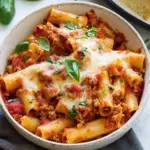Eggs Benedict is the epitome of brunch luxury—a perfectly toasted English muffin layered with savory Canadian bacon, a delicately poached egg, and a generous pour of velvety, homemade Hollandaise sauce. Every bite offers a balance of texture and flavor that’s both comforting and sophisticated.
This recipe allows you to recreate a restaurant-style breakfast right from the comfort of your kitchen. The real star here is the Hollandaise: smooth, buttery, and made with just a few pantry staples. Whether you’re planning a weekend brunch for friends or treating yourself to a morning feast, this dish delivers elegance in every bite.
Full recipe:
Ingredients:
-
2 English muffins, split
-
4 large eggs
-
4 slices Canadian bacon
-
Splash of vinegar (for poaching)
For the Hollandaise Sauce:
-
4 tablespoons unsalted butter
-
4 large egg yolks
-
2 teaspoons lemon juice (or lime juice)
-
1 tablespoon heavy whipping cream
-
Salt and black pepper, to taste
Directions:
-
Make the Hollandaise Sauce: Melt butter in a small saucepan over low heat. In a separate bowl, beat egg yolks with lemon juice, cream, salt, and pepper.
-
Temper the eggs by slowly whisking in a spoonful of the hot butter at a time, then pour the tempered yolk mixture back into the saucepan. Cook on low heat, stirring constantly, for 20–30 seconds until thickened. Remove from heat.
-
Poach the Eggs: Fill a pot with 3 inches of water, bring to a boil, then reduce to a gentle simmer. Add a splash of vinegar. Crack an egg into a cup, then gently lower it into the water. Cook for 3–5 minutes depending on desired yolk consistency. Remove with a slotted spoon.
-
Prepare the Canadian Bacon: In a skillet over medium-high heat, sear Canadian bacon slices for 1 minute on each side.
-
Toast the English Muffins: Toast both halves until golden and crisp.
-
Assemble: Place a slice of Canadian bacon on each toasted muffin half, top with a poached egg, and drizzle generously with Hollandaise sauce.
Prep Time: 10 minutes | Cooking Time: 25 minutes | Total Time: 35 minutes Kcal: 348 kcal | Servings: 4 servings
A Culinary Classic with a Mysterious Origin
The exact origin of Eggs Benedict is somewhat disputed, with a few stories competing for authenticity. One widely cited version credits a retired Wall Street broker, Lemuel Benedict, who in 1894 allegedly ordered “buttered toast, poached eggs, crisp bacon, and a hooker of hollandaise” at the Waldorf Hotel in a bid to cure a hangover. The hotel’s maître d’hôtel, Oscar Tschirky, was so impressed with the order that he refined it into the version we know today, replacing toast with English muffins and bacon with Canadian bacon.
Another claim suggests the dish was created for Mr. and Mrs. LeGrand Benedict, regular patrons at Delmonico’s restaurant in New York, who were bored with the menu and requested something new. Whatever the truth may be, what’s undisputed is that the dish quickly gained fame and became a staple in American brunch culture.
Why Eggs Benedict is So Popular
One reason for the lasting appeal of Eggs Benedict is its multi-layered flavor and texture. Each component plays a distinct role. The English muffin offers a sturdy, slightly chewy base that absorbs the yolk and sauce beautifully. The Canadian bacon introduces a savory, slightly smoky meatiness that balances the richness of the other ingredients. The poached egg contributes an essential creaminess and a delicate protein element. Finally, the Hollandaise sauce—a warm emulsion of egg yolks, butter, lemon juice, and seasoning—ties everything together with its silky, tangy profile.
This combination is not only comforting but also visually stunning. When cut open, the egg yolk spills out, mingling with the sauce and bacon, creating a decadent mix that feels luxurious and satisfying. It’s no wonder this dish has transcended breakfast menus and become a brunch must-have across the world.
The Magic of Homemade Hollandaise Sauce
What truly elevates this dish is the Hollandaise sauce. While some opt for store-bought mixes, making the sauce from scratch transforms the meal into something extraordinary. Traditional Hollandaise is a delicate balance of technique and timing. The key is in tempering the egg yolks slowly with hot butter so they don’t scramble, then gently heating the mixture until it thickens to a silky consistency.
It’s a sauce that’s as much about intuition as it is about method, rewarding patience with a texture and flavor unmatched by packaged alternatives. The addition of lemon or lime juice cuts through the butter’s richness with a light citrus brightness, adding complexity and balance. This sauce is notoriously tricky to master, but once you do, it becomes a prized tool in your culinary repertoire, useful not just for Eggs Benedict but for vegetables like asparagus, fish like salmon, and even steak.
A Dish of Variations and Adaptations
Another reason for the enduring charm of Eggs Benedict is its versatility. Once you’ve mastered the basic structure, the dish becomes a canvas for experimentation. A popular vegetarian version, Eggs Florentine, replaces the Canadian bacon with sautéed spinach. Smoked salmon can be used instead of meat, resulting in the sophisticated Eggs Royale. Some creative versions use crab cakes, avocado, tomato slices, or even pulled pork in place of the traditional bacon, offering endless customization options.
Chefs often put their own twist on the dish by altering the seasoning in the Hollandaise sauce, incorporating ingredients like Dijon mustard, cayenne pepper, chives, or tarragon. Even the English muffin can be swapped out for artisan bread, sourdough, or biscuit-style bases. The flexibility of Eggs Benedict is part of what makes it a modern brunch darling—it can be classic or contemporary, indulgent or lightened-up.
How to Serve Eggs Benedict Perfectly
Presentation plays a vital role in the Eggs Benedict experience. Ideally, it should be served immediately after assembling, as the sauce can thicken and the eggs can cool quickly. A warm plate helps maintain temperature, and garnishing with a sprinkle of paprika, fresh herbs, or microgreens adds both visual appeal and a burst of flavor.
Serving this dish with a side salad, crispy hash browns, or fresh fruit creates a balanced brunch plate. Pairing it with beverages like fresh orange juice, champagne, or a light mimosa elevates the meal even further. It’s a dish made for slow mornings, special occasions, or impressing guests with a gourmet flair.
A Dish That Demands and Rewards Attention
Despite its elegance, Eggs Benedict is not a “quick and easy” breakfast. It’s a dish that demands attention and coordination—the sauce must be made carefully and timed right with the poached eggs, which require their own set of skills. The bacon must be heated just right, and the muffins toasted to perfection. Yet, that very complexity is what makes it feel so special.
Cooking it at home for the first time can feel intimidating, especially the process of poaching eggs or mastering Hollandaise. But with practice, the steps become second nature. For many home cooks, the first successful attempt at Eggs Benedict is a milestone—proof of a growing skill set and a commitment to quality.
The Emotional Connection to Eggs Benedict
There’s a nostalgic and emotional element tied to this dish for many people. It’s often associated with celebratory brunches—Mother’s Day, birthdays, anniversaries, or simply weekends when there’s time to savor a good meal. The effort involved often turns it into a labor of love, a meal prepared to show appreciation, care, or celebration.
For some, it becomes a family tradition. Parents pass down their Hollandaise secrets or favorite twists on the recipe. Couples perfect their own version for weekend breakfast rituals. Food, after all, isn’t just about nutrition—it’s about connection, memory, and joy. Eggs Benedict embodies all of that.
Conclusion
Eggs Benedict is far more than just a breakfast dish—it is an experience that combines tradition, technique, flavor, and artistry. From its mysterious origins in New York to its status as a global brunch favorite, it has stood the test of time as a symbol of indulgence and elegance. The delicate balance of poached egg, savory meat, toasted bread, and silky Hollandaise sauce is a testament to the power of simple ingredients handled with care.
Whether you’re making it for a quiet weekend morning or a special gathering, preparing Eggs Benedict at home offers the chance to slow down and savor not only the food but the ritual of creating it. It’s a dish that teaches patience, rewards effort, and never fails to impress. In a world of quick meals and shortcuts, Eggs Benedict reminds us of the joy found in making something with intention—and enjoying every bite.






